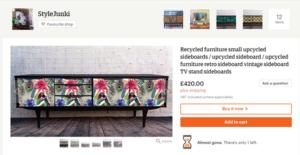You may have been tricked into buying something from an online retailer like Amazon, Etsy and Boohoo before, without realising it until it’s too late.
According to a new report from user experience design agency Sigma, “dark UX patterns” are the source of manipulation – and they’re being used against our better interests.
Sigma – whose previously provided tips on how to design a website for people with disabilities or mental health – has looked into how online stores like Amazon, Etsy and Boohoo are using unethical UX design techniques to manipulate buyers to spend more, such as micro-copy, scare tactics and colour theory.
The agency’s report follows the busy Christmas and New Year online shopping periods, where UK retailers took £25 billion in sales over the Christmas period alone in 2016, nearly half of which was made through a mobile device.
More of us are opting to buy things online to beat the bad weather and the crowds around busy times like Black Friday, Christmas and January. But are we being somewhat scammed?
Following on from its initial report a year ago, Sigma says although it never intended to single out brands, it has anyway by suggesting Amazon, AO.com, Very, Pretty Little Thing and Boohoo, Etsy and Currys persuade and dissuade consumers in ways that benefit the brand rather than us, the user.
Tactics such as vague micro-copy with confusing opt-in and opt-out checkboxes, and colour theory to misdirect purchases at the checkout lead Sigma to question the ethics of the retailers.
We take a look at some of Sigma’s allegations against a selection of well known online retailers.
 Amazon
Amazon
Sigma clicked to buy a television from Amazon and, instead of clicking through straight to either the basket or the checkout pages, a breakdown cover product pop-up appeared, drawing attention toward the yellow ‘Add to basket’ button and away from the grey ‘No thanks’ button, as seen here. This could lead to an unnecessary purchase.
It’s not just businesses adoting this tactic. Sigma says similar techniques have been used by charities when asking for donations. London Zoo is an example, giving the customer an option of ‘add to basket without donation’ or ‘add to basket with donation’ with equal weighting, with the latter option to the right; a usual place for users to proceed.
Furthermore, it’s also not instantly clear how much the user would be donating. Although the UX design has been improved.
 Very
Very
When purchasing something from Very, micro-copy makes ticking and unticking boxes confusing. Take a look at the contradictory checkboxes – one is opt-in and one is opt-out.
 Pretty Little Thing and Boohoo
Pretty Little Thing and Boohoo
Both these online clothing retailers look to use limited duration as a way to encourage users to purchase items within a given time frame, Sigma says.
However, when Sigma visited both sites on multiple occasions, it revealed that the offers were available for longer than the stated duration.
Therefore it seems as though the user is pressured into buying anything in order to achieve the offer for fear of missing out on what appears to be a good deal.
Could a similar strategy be found on the high street? Depends on who you get on the shop floor or at the till. The point here is that instead of having the option to haggle your way to a better deal, the system is deliberately set up to make sure the fear of missing out on a bargain is felt most acutely.
 Clas Ohlson
Clas Ohlson
Home store Clas Ohlson was found to be offering a hardware product on sale advertised as a ‘clearance’ sale, yet the offer is valid until July 2018. Pricing error or cynical attempt to create buzz?
 Currys PC World and AO.com
Currys PC World and AO.com
These electrical retailers offer further, slightly hidden discounts to sale items for users to apply during the checkout process, according to Sigma.
The agency says it couldn’t find a promotional code to add to the product in the subsequent checkout process in the case of AO.com, but Currys did uphold the promotional offer.
However, Sigma argues the promotional codes tempt people into buying items already on sale but then they put the onus on the buyer to remember to apply these codes which, Sigma says, are not well signposted in the checkout process.
 Etsy
Etsy
Etsy lets the buyer know there are a limited number of a particular product available – ‘scarcity tactics’ as Sigma labels it.
Although Sigma acknowledges Etsy is for independent retailers to market and sell their goods, and items can often be made to order, the wording and micro-copy doesn’t provide accurate information.
Improvements fail to impress
Sigma says although the retail landscape is extremely competitive at the moment, it’s concerning that big-name brands are still trying to attain more money, data or marketing channels to users.
It was hoped improvements would be noticed from a similar report last year, yet the “unethical practises are still very much in place,” Sigma says.
“The examples listed above are just a brief cross-section of what we know is happening across the board – not just in retail, but in the leisure, travel and third sectors, too.
“User experience strategies are supposed to do just that; guide users through a site in the easiest and most transparent way possible… retailers would do well to remind themselves of this in future.”
IDG News Service








Subscribers 0
Fans 0
Followers 0
Followers